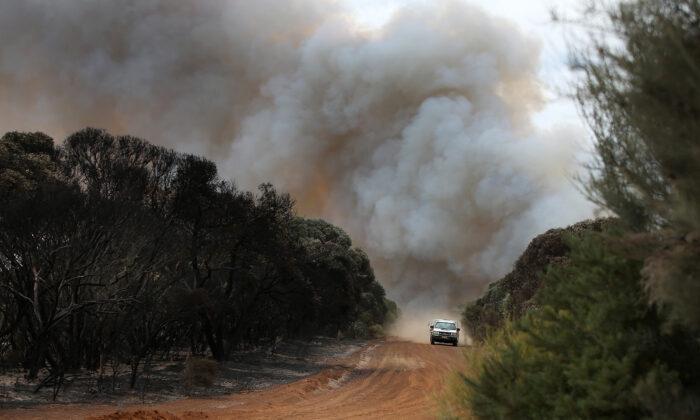BODALLA, Australia—Crews battling Australia’s wildfires said on Jan. 12 that they’ve been able to turn from defense to offense for the first time in weeks, thanks to a break in the weather.
Dale McLean, who is helping manage the response to a fire near the town of Bodalla in New South Wales state, was part of a team that was bulldozing down small trees and burning scrub ahead of the fire’s projected path to try to stop it from reaching a major highway by starving it of fuel.
“This fire took a major run about seven or eight days ago, and with the weather changing now, the weather settling down, the fire has settled down,” he said. “The fire behavior has changed. So we’re able to get in front of the fire now, get on the offensive.”
Other workers echoed McLean’s comments, saying cooler temperatures and mild winds have finally offered them a chance to make progress. The weather is expected to remain benign for the next week, although any deterioration in conditions after that could see the wildfires flare up again.
While battling the blazes, volunteer firefighting veteran Mick Stain found some moth larvae, or “witchetty grubs,” and turned them into what’s known in Australia as bush tucker by roasting them directly on the fire’s burning coals.
“Bit creamy and nutty, but they’re all right,” Stain said. “They’re not spew-worthy, so they’re pretty good.”
Meanwhile, U.S. tennis star Serena Williams donated her $43,000 winner’s check from New Zealand’s ASB Classic to the fundraising appeal for victims of the wildfires, joining many other tennis stars to pledge money, including Ash Barty, Nick Kygrios, Novak Djokovic, and Maria Sharapova.
Also on Jan. 12, news came that another firefighter had been killed. Bill Slade—one of the few professionals among mainly volunteer brigades battling blazes across southeast Australia—died after being hit by a falling tree on Jan. 11 near Omeo in eastern Victoria state, Forest Fire Management Victoria Executive Director Chris Hardman said.
The 60-year-old married father of two was commended in November for 40 years of service with the forestry agency.
“Although we do have enormous experience in identifying hazardous trees, sometimes these tree failures can’t be predicted,” Hardman said. “Working on the fire ground in a forest environment is a dynamic, high-risk environment, and it carries with it significant risk.”
The tragedy brings the death toll to at least 27 in a crisis that has destroyed more than 2,000 homes and scorched an area larger than the U.S. state of Indiana since September. Four of the casualties have been firefighters.
Prime Minister Scott Morrison announced that 76 million Australian dollars ($52 million) would be spent on providing psychological counseling for firefighters and fire-affected communities as part of a previously announced AU$2 billion ($1.4 billion) recovery fund.
“There has been a deep scar in the landscape that has been left right across our country,” Morrison said. “But I am also very mindful, as is the government, of the very real scars that will be there for quite a period of time to come for those who’ve been exposed to the trauma of these bushfires.”
While the fire threat is most acute in rural communities, wildfire smoke that has choked some of Australia’s largest cities is a reminder to many urban Australians of the unfolding disaster.
Smoke again sheathed Sydney on Jan. 12, almost a new normal for the country’s biggest city, moving the air quality into hazardous territory, according to the NSW Department of Primary Industry index.
Since October, thousands of Australians have been subjected to repeat evacuations as huge and unpredictable fires scorched more than 10.3 million hectares (25.5 million acres), across New South Wales, 111 fires were still burning on Jan. 12, 40 of them not yet contained, but none at emergency level.
A number of fires burning in the Snowy Mountains region in New South Wales and across into Victoria have merged across more than 600,000 hectares (1.5 million acres) of land. They do not pose a threat, authorities say, despite being in an area hard to reach.
South Australia said on Jan. 12 that more than 32,000 livestock animals, mostly sheep, have died in recent fires on Kangaroo Island, while fire services are working to strengthen containment lines ahead of expected worsening weather conditions on Jan. 13.
About 100 firefighters from the United States and Canada are helping, with another 140 expected in the coming weeks.





